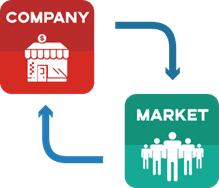
Marketing Defined. Marketing is the process of continuously and profitably satisfying target customer’s needs, wants, and expectations superior to competition.
Note the six key elements in the marketing definition:
- Continuously – refers to maintaining a relationship, i.e., pursuing high repeat purchase levels and not just one-time transactions.
- Profitably – means having a revenue model that allows the company to capture the economic value of what it offers, as seen in the level of cash flow earned to finance operations.
- Satisfying – is about identifying and understanding what drives the customers to buy or not to buy, and creating a plan to ensure customers are happy and not remorseful about their purchase and usage.
- Target customer – pertains to a particular customer group or groups chosen, as those who can best benefit from the purchase and usage of the company’s products or services.
- Needs, wants, and expectations – refers to the minimum as well as determining dimensions in a purchase (or what the target market is looking for in a product or service); these dimensions are used to communicate, persuade and influence target market’s purchase behavior.
- Superior to competition – means not just making customers happy but preparing an offering in such a way the customer will choose a company over its competition. Being better than competition considers other customers’ barriers to purchase such as customer indifference, doubt, procrastination, and similar attitudes.
Marketing Concepts. The marketing definition above lays the groundwork for understanding the five interrelated marketing concepts, specifically:
- The two interacting components of company and market
- The two interacting components of a market
- The Strategic 3Cs of Marketing
- The Input and Output of Marketing: sales, market shares, profit
- The Marketing Philosophy of being better than before, better than others, better than expected.
Depending on the culture or the context of the industry of the business, how the marketer understands (or prefers) these concepts is how he or she will execute or accomplish the marketing tasks in the company.
The most basic concept starts with locating marketing in the interaction between two main components, and these are the company and its target market.
Figure 1-1: The Two Interacting Components of Marketing

A marketer should always consider the strengths and weaknesses of his company in serving the needs and wants of their market. They must therefore choose the market segment or segments where they can have potential leadership or at least have a strong and profitable challenger role. Marketers should have a balance between the company’s requirements for profit and desired market standing.
A market, on the other hand, is composed of people or organizations that have the need, can pay (in cash or equivalent), and have the authority to decide to make the purchase. The above interacting equation between the company and the market shows that both parties are equally important. Satisfying one party (for instance, the customer only) without satisfying the other is not good marketing.
The market is also composed of two other interacting components: customers and competition, and this leads to the next concept. Customers, who may either be trade intermediaries (like wholesalers or retailers) or consumers (end-users), are organizations or people buying from you; while competitors are those with products or services that can offer similar benefits as yours to your customers.
Figure 1-2: The Two Interacting Components of a Market

The overriding objective of the company is to develop a relationship with the customers, then maximize a competitive advantage that addresses gaps in the customer’s world. This means that companies must primarily know the unsatisfied problems of the customers, then provide a relevant solution while being profitably superior to their competition.
Combining the two concepts above will lead to the next one where the three interacting components of marketing are presented with equal importance. This is the strategic 3Cs of marketing: Customers, Competition, and Company.
Figure 1-3: The Strategic 3Cs of Marketing

The key objectives and some examples of the 3Cs of marketing are put together below:
- Customers: To satisfy customers
- Competition: To outperform competition
- Company: To ensure corporate health and profit.
Note that the marketing definition is further clarified in the key objectives of each of the 3Cs of marketing. Companies must be marketing-oriented, i.e., being more holistic or aware of the entire scope of the 3Cs of marketing, versus being just market- oriented which simply seeks to satisfy customers’ needs better than their competition.
As a result of marketing activities, the output expected from Customers, Competition, and Company is collectively called Key Result Areas (KRAs). These outputs are sales, market shares, and profit, respectively, as shown in Figure 1-4.
There is another output not in the figure and that is market penetration. It is classified separately because it is linked to a firm’s efforts not just to increase sales but also to get sales volume specifically from new users. This is known as a market- driving strategy in contrast to market-driven strategy, which is about attaining sales only from existing customers.
Figure 1-4: Input and Output of Marketing

Another marketing concept is the marketing philosophy (first introduced by Go, 1992) of “being better than before, better than others and better than expected” which can provide a standard for judging marketing effectiveness.
“Better than Before” must be the norm of the company in evaluating sales vis- à-vis the industry’s growth rate. This is especially true since all firms need to sell more than before to improve both profitability and market shares, given increasing expenses and competition. The key is both customer bonding and continuous market penetration.
“Better than Others” must be demanded by the company in improving market share performance which reflects how they fare against competition and substitutes. The key is in the formulation of sources of growth and competitive advantages.
“Better than Expected” must be practiced in evaluating profit performance, especially when a corporate budget is prepared. The key is maximizing revenues while avoiding non-strategic expenses that do not contribute to business building.
Figure 1-5: Standard for Judging Marketing Effectiveness

***
Josiah Go is Chairman and Chief Innovation Strategist of Mansmith and Fielders Inc.

See more articles on Marketing.


